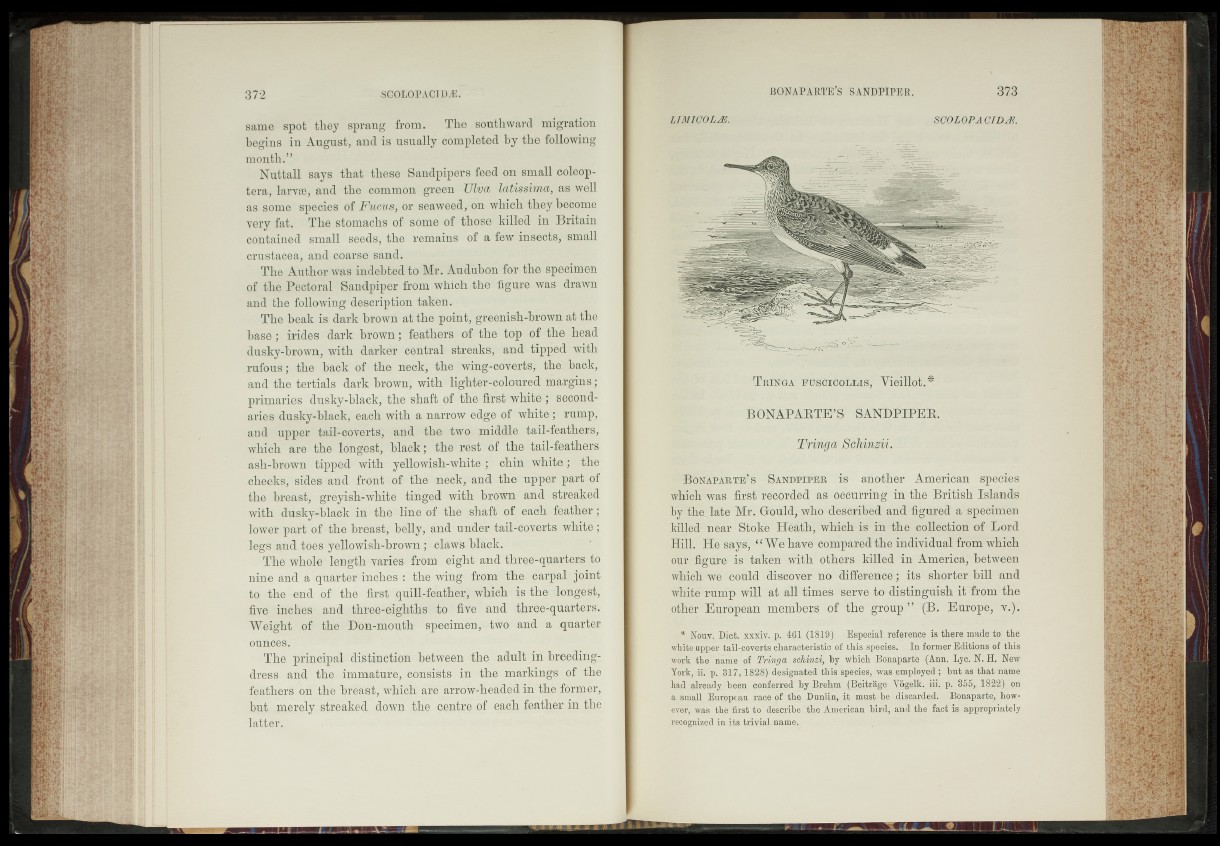
same spot they sprang from. The southward migration
begins in August, and is usually completed by the following
mouth.”
Nuttall says that these Sandpipers feed on small coleop-
tera, larvae, and the common .green Ulva Idtissima, as well
as-some species of Fu.cus, or seaweed, on which they become
•very fat. The stomachs of some of-those killed in Britain
contained small seeds, the remains of a few insects, small
Crustacea,, and coarse sand.
' The Author was indebted to Mr. Audubon’ fopthe specimen
of the Pectoral * Sandpiper from which the‘ figure .was drawn
and* the following description taken. •
The beak is dark brown at the point, greenish-browhat*the
base; irides ;dark brown; feathers^of'the top of"the‘head
dusky-brown, with darker central streaks, and- tipped- with
rufous; the back of- t'He rfeck, the wing-cbVertsf the^back,
and the tertials'dark brown, with* lightefeeoloured margins;
primaries dusky-black, the shaft of the first whited secondaries
dusky-black, each with a marrow edjgfeof 'white rump,
and upper tail-eoverts^ and the tw© middle -tail-^a%ers,
which are ^fne" longest,' black; ‘the rest“ of the tail-feathers
ash-brown tipped with yellowish-wh'it^ chin.. -whi||J| the
cheeks, sides and front ’oft-the^ndckv'and the" uppeu;p'artmf
the breast;’ greyish^white tinged with brown and streaked
with dusky-black in the "-linek)f' the ishaft:-of--earc,^ fe a fh e r;
lower part of the breast, -belly, and mUder- tail^ofeefitswhi-t© ;
legs' and .toes-yello wish-brown ; Jslaw®.’blaek>J‘^
Tb# whole length?waries from ei|fft and thre^quaiter&’tp
nine and a'^qutfrtbr%ieh-es^: the wing from?-the carpal jUint
tor-the end of the first quilf-^ther, -Whtfch is tfieiflongfest,
five-inches and three-eighths to fcwefcYand ■ three-quarters.
Weight of -the Pon-mbuth ’^ ^ im ^ ^ tw o ^ aU ’d *«- qiurh r
ounces?^
The principaKtli^t^ctitetib6t%eeh i^^%duft^h4)Ee%S&.g-
dress and the imrnatu^ejicSaisists in the markings of the
feathers on the breast^which are ■arrowT^efled m thp former,
fiut -jnejelj streaked down 4btg -centre jtff. ej.ich feqt^pr in tluj
-latter.
' TErNOA^kt-s^rcohEis, ’ TieiHbtfi^
: BONAPARTE’Sf
: . Wringa
Bo n a p a e p i p e r ?#s/J another American- species
Wbich^wa’s firsfirecorded M;%Jcurring in the British Islands
by'theL.late M rG o mi d ,^KcP desepb e d and figured a specimen
•ilHed^near%toke Heatb^’ which' is in ’the collection of Lord
Bfflv He says* ^W e have cbmpalgdfhe'individual from'’which
oub -figure is-taken with others killed Hnc America, b Ivun*
which-*w^feould discover no“'dffferehe'e^ its shorter' bilEf and
wb|te rump wris at allfiimffisferve to distinguislffif^from' the
P®erEuropean nfenmeVs of "the* group-^'(B. Europe, vff.
Bi&t •xx4v- - .E^peciaf ref^reaqe-iis there, ma,devtpr the
glMte upper .tail-coverts characteristic oi’ this ‘-pcctgs.,» Jp. former Editions of this
Vork timAyne-*^ Tringa whi^zi, by wifeh Bonaparte* (Ann. New
York, designfte.a.' tbas:Apeeies, wasxinployed ; but as thatAanfe
had ,‘^lready|h.ee»£nonfpjrgd h y j^ e ly n ^ j^ tra g !| 'V^ge.lk. ail- ^ ,
a small European racjgnf thp Dublin, jjj. must-lporjliscardje.cL.~-- Bonaparte, how;
tneSiist (describe ifiip A‘nieiiq|p bird, ‘and the fact’is'-appropriately
fifigpgnized in its triyiai name,